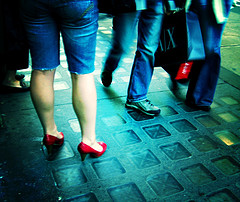( . . . in both sentences of the word.)
In “The Science of Fairy Tales,” Chris Gorski takes on the issue of reality and fantasy. Or, well, sort of. The author writes about what possible truths may exist in fairy tales and selects three popular stories with elements that seem to have a basis in reality. She/he asks,
[A]re the most magical moments from some of our favorite stories actually possible? Basic physical principles and recent scientific research suggest that what readers might mistake for fantasies and exaggeration could be rooted in reality.
At first I took this comment to mean a girl named Rapunzel, a mermaid named Ariel, and a young man named Aladdin did indeed, respectively, let down her hair, have stolen her voice, and make fly his carpet — feats that bend our perceptions of the tangible world. But, then, I gave the article a second read and realized this final line is vague enough to mean just about anything. Once “could,” “may,” or “suggest” hedges an argument, what follows could be any bit as hyperbolic as the speaker/writer wants, for better or for worse.
I’ll try not to ruin the surprise of what’s contained in the article — I’m already plenty amused and even appreciative that a science news researcher would attempt to unite folklore and “hard-core” reason. I may never have tied a strand of my hair around candy bars to gauge the strength of my locks, attempted to bend sound waves like light, or released a rug in midair like the napkin that never fails to fly off the picnic table, but, sure, I see these insights have some basis. (I think I’m entirely failing at not giving away the details of the article.)
And, yet, I can’t help but spend a little time with the following line, which is Gorski’s segue into the body of the article and which uses language that initially made me feel as if I’m being beckoned into a funhouse:
So suspend your imagination for a moment, and look at the following fairy tales as a hard-core scientist might.
But, it’s not a funhouse – or, well, maybe it is. We’re entering the realm of hard-core scientific reasoning. We are asked to suspend our imagination in a clear reversal of the popular attempt to suspend disbelief, which we try to do when, say, we enter a movie theater. We suspend our disbelief so we can enjoy the imagination and creativity brought together for our entertainment, for our temporary relief from the daily grind, and for our currency . . . but I digress. For some moviegoers, we suspend our disbelief in order to open ourselves up to ways of thinking and experiences foreign to us, foreign for any number of reasons. We suspend our disbelief to take in, learn, and appreciate.
This approach is not necessarily our default, however. We doubt until there is reason to believe, or we remain indifferent until we become invested. The Harry Potter generation will tuck away their crimson and gold scarves just as older generations would have done with their ruby-red slippers had the mechanism and culture existed in that age to produce and market such paraphernalia.
Let’s not forget, however, that the author is asking us to look at fairy tales as a scientist would. This writer seems to point to scientific reasoning as having little to no use for the imagination. Yet, in all honesty, I’m wondering who could possibly believe that Ariel losing her voice has to do with an average someone discovering sound waves can be bent. Tell me this thought doesn’t take a little bit of imagination, a slight suspension of judgment and doubt.
By the conclusion of the piece, a slight hope began to build for me:
Perhaps some fairy tales are more grounded in reality than others. Or maybe these precious stories are exactly what we thought they were. An idea is fertilized by the imagination and expanded beyond what seems possible. Or maybe science has come so far over the years that scientists are looking beyond the problems of the physical world and into the imaginations of children for their inspiration.
Again, the “perhaps”s and “maybe”s can be frustrating, or they can be hopeful. And my reading of this final line can similarly be frustrating (moving from the problems of the physical world to the problems of children’s imaginations) or hopeful (moving from the problems of the physical world to the reason-bending imaginations of children . . . um, who aren’t really the authors of these fairy tales). Or perhaps this paragraph finally shows that, indeed, ideas do come out of the imagination, and its direction thereafter is up to the thinker. And I can’t help but think of one such method: the scientific method. First a person posits a hypothesis and then attempts to prove it. And an unproven hypothesis is an educated guess, right? And a guess is an idea, no? And do not even proven hypotheses change in value over time as researchers imagine new ways of approaching knowledge and dissecting our physical world? Will time come, again, when we’re told dark chocolate is not really that good for us after all?
I admit I like the idea of culture and science coming together in newish forms, but if the main reason is to bring reason itself to the imagination, I can’t help but feel somewhat uncomfortable. I believe in the intermingling of ideas (I mean, shoot, I’m helping launch a digital magazine named Harlot precisely because I believe in interdisciplinarity and the value of discussion held beyond the university) but not when one category (especially the one less tied down by rules) becomes stifled.
In the end, though, I sigh and think that if a person refers to these particular moments in our popular fairy tales as “the most magical,” perhaps, maybe, possibly the two of us are on different (bent?) wavelengths after all. But I’m not sure which one of us is trapped within an enclosed and muffled space, perhaps with a bonfire projecting strange shapes and figures onto the walls.



